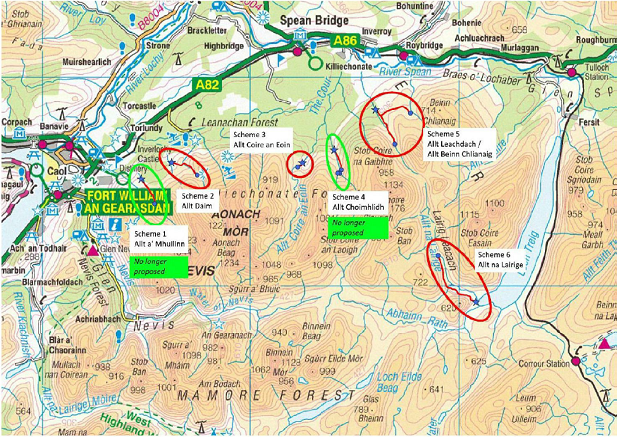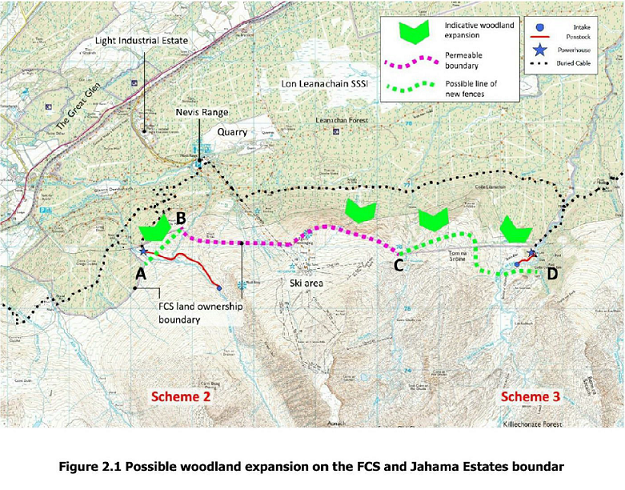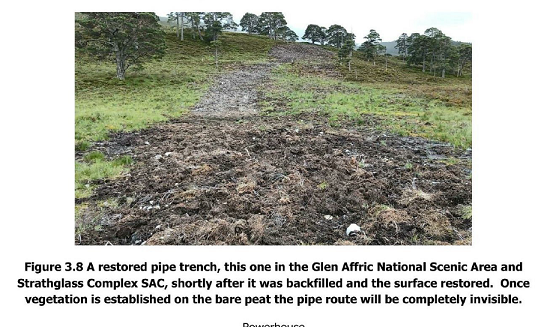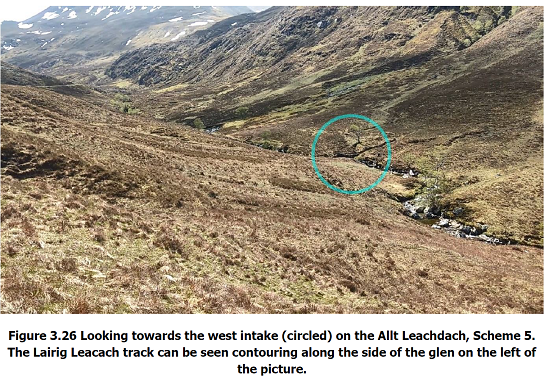
Four more hydro schemes are being proposed in one of the most special parts of Scotland which, if it were anywhere else in the world, be a National Park. Unlike the proposed schemes in Glen Etive (see here), which I hope to post more on soon, these schemes have so far received little attention from the general public. Mountaineering Scotland has, however, lodged excellent objections to two of the proposed schemes and raised serious concerns whether the others can be constructed in the way the developers claim – leaving no trace. I make no excuse for straying outwith Parkswatch’s usual remit to consider the issues. At the end of the post I suggest its time to trail a new initiative, hydro watch, which would enable people to share what is really going on, good and bad, with hydro developments across Scotland
Background
In December 2017, SIMEC Energy, a part of GFG Alliance which is a global business group, bought Green Highland Renewables (GHR), from Ancala Partners, an investment firm. GHR has been one of the main developers of hydro schemes in the Highlands while SIMEC Energy is planning a large windfarm at Glenshero, near the edge of the Cairngorms National Park. GFG Alliance also owns Liberty Steel, which bought the Fort William Aluminium Smelter in 2016 (while SIMEC bought the Loch Treig Hydro Scheme). Another GFG company, Jahama Highland Estates now runs the extensive landholding, formerly known as Alcan Highland Estates, on which the four hydros are mainly located.
The big idea behind SIMEC/Liberty Steel is greener less carbon intensive production of metals – something that should be strongly supported. SIMEC-GHR, however, claim in the Planning Application that these four hydro schemes are needed to secure the new alloy wheel factory being built alongside the Aluminium Smelter at Fort William and the associated new jobs. Molten aluminium will run from the smelter straight into the factory and be converted into wheels. This will significantly reduce the overall energy consumed in the production process avoiding the need for the aluminium to be is re-melted when taken for processing into goods elsewhere. The additional energy consumed by the new factory will be much less than what is saved. The concept is therefore a good one. Whether these run of river schemes are necessary to produce or secure that extra energy as claimed, however, is highly questionable.
The Loch Treig and the Blackwater Reservoir power schemes have NEVER been sufficient for the Lochaber smelters when water levels drop in summer. SIMEC appear to claim that these four new hydro schemes will make up this deficiency. Its hard to see that happening whent the water from three of the schemes will drain into the Loch Treig Scheme. When the water is low there, it will be low in the feeder burns, as happened this May, and they are unlikely to produce much additional power.
The main Environmental Impact Assessment Report contains NO information about the size of these four schemes compared to the main Loch Treig power station although it may be hidden among one of the many nameless appendices to the Environmental Statement. I am not sure this matters. We know that hydro schemes produce small amounts of power and its extremely unlikely that these schemes are crucial to the future of low carbon metal production at Fort William.
I believe therefore that the public and Highland Council should focus on what is actually being proposed.
The Planning Application
In October, after extensive discussion with statutory agencies, SIMEC GHR submitted planning applications for four hydro schemes from Aonach Mor to Loch Treig. On the advice from public authorities they dropped a scheme proposed for the Allt Mhuilinn, under the north face of Carn Dearg on the Ben and for the Allt Choimlidh (see map above).
The applications contain detailed reports on the ecology of the land affected by these schemes. This appears to have been driven by SNH, which is much concerned about protecting the Ben Nevis Special Area of Conservation. A previous scheme for the Allt Coire an Loin, which would have involved flooding 850m of the glen, was ruled out in 2014 because of its impact on plants. The new proposal is as a consequence lower down and that is also why SIMEC-GHR say they have dropped the Allt Choimlidh scheme. It is for this reason, rather than the landscape impact, that they also claim to have dropped the Allt Mhuilinn scheme which would have installed a hydro right under the cliffs of Carn Dearg on the north side of Ben Nevis.
The SIMEC-GHR Environmental Impact Assessment Reports (one covers the three schemes on the north side of the ranger and another the scheme on the south side of the Lairig Leacach) pay almost no attention to the impact of the schemes on either the Ben Nevis-Glen Coe National Scenic Area or the Rannoch -Nevis – Mamores – Alder Wild Land Area:
“An assessment of effects on landscape character, National Scenic Areas and Wild Land was undertaken, and the results, which show that there would be no permanent significant adverse effects, are included in the EIAR, with the mitigation measures also included in the EIAR.”
This is despite the report also stating:
“The landscape is considered to be highly sensitive to change, partly because of its designation as a NSA.”
More specifically their assessment of the impact of the Allt na Lairige on Wild Land is shocking:
“7.7 Wild land
The scheme would be built in an area which has been identified as a “core area of wild land” by SNH.
Impacts on the wild land have been assessed in accordance with the method laid down by SNH. The
conclusion is that there would be no significant effect on the wild character of the area.”
So, a concrete powerhouse in the middle of nowhere has no significant effect on the NSA or Wild Land Area?
Mitagatory measures
Despite this disregard of the statutory designated NSAs and of advice on Wild Land Areas, where there is a presumption against development, SIMEC-GHR have proposed two measures to mitigate the landscape impact of the proposals.
The first is that the developer says that the construction tracks, with the exception of a small stretch of new track in the forest, will ALL be removed.

This is very welcome. Parkswatch has provided lots of evidence that usually the main landscape impact of hydro schemes in our National Parks are the access tracks. That SIMEC-GHR believe such tracks are not necessary to service the hydro intakes totally undermines the Loch Lomond and Trossachs National Park Authority’s claim that tracks are essential for maintenance purposes. (I look forward to the LLTNPA now reviewing all the tracks it has now consented to unnecessarily).
There is a “but” however! The John Muir Trust response to the three applications on the north side of the range (see here), which in my view is far weaker on the need to defend Wild Land and scenery than those of Mountaineering Scotland, does reveal a very interesting fact that is not made clear in the application:

It appears that instead of removing the tracks completely – they will be created by the importation of crushed aggregate – SIMEC-GHR will simply try and cover them up with vegetation. That is NOT removal in the true sense of the term and will have a permanent impact on vegetation, ecology and landscape. It also creates the risk that vehicles will still be used to access the hydro intakes. Highland Council should clarify with SIMEC-GHR their plans and insist that any aggregate used to construct temporary access tracks is removed entirely.
The second proposed mitigation measure is that a new deer fence should be constructed along the boundary of the Forestry Commission and Jahama Highland estate boundaries:

This would allow natural regeneration to take place above the boundary of the current plantations, so softening it – a landscape improvement – and at the same would help conceal the lower part of the Allt Daim Scheme (2 on map) and the Allt Coire an Eoin Scheme (3 on map).
The Planning Applications contain many other proposals on points of detail for how the impact of the schemes will be mitigated, from location of the intakes and power houses to restoration of vegetation. This is all also welcome although in my view there are still some significant gaps/unresolved issues.
Will the plans, as described, be implemented if approved?
The John Muir Trust, while not objecting to the three schemes on the north side of the range, rightly draws attention to the record of Green Highland Renewables:

Proof of this is conveniently provided in the application with GHR’s illustration of their restoration works in Glen Affric:

Notice all the dead vegetation and bare peat. Had the vegetation been restored properly this should never have happened.
An even stronger indictment of GHR’s record is provided by the response (see here) from Spean Bridge, Roy Bridge and Achnacarry Council, which while supporting the aspirations of greener aluminium production has this to say about SIMEC/GHR’s record:
“SIMEC GHR prior to their acquisition by GFG Alliance planned and constructed a similar series of Micro Hydro Schemes in Loch Arkaig. They received a glowing testimony from a local group at the application stage, but the construction phase was anything but straightforward. There were numerous complaints about inappropriate behaviour by contractors, the lifeline access B8005 was often closed to recover HGV’s from ditches in the Dark Mile and there were outages and electricity supply difficulties for residents during the grid connection phase.
To ensure no repetition in this new application we have had three meetings with the developer, and they have sought to allay our concerns with assurances that our previous experience would not be repeated, and that there would be minimal impact on the Corriechoille Road and the village of Spean Bridge.
Although Volunteers we have painstakingly read the many attachments to these three applications, and been extremely disappointed to find absolutely no mention of the fact that at this time SIMEC GHR do not have access confirmed for either construction vehicles or grid connection across the pivotal Killiechonate Estate. Furthermore they have suggested that in partnership with other Landowners including the estate in question they will use the iconic Puggy Line for grid connection and reinstate it afterwards. Once again a premature statement as they neither own the land nor have reached any agreement with the owner. Indeed from our discussions with the estate in question it would appear that they did not have permission to access the forestry roads to compile all the supporting information in this application.
As a Statutory Consultee we expect Developers to submit Applications that are both comprehensive and accurate, and this reprehensible conduct by an arm of GFG Alliance does not inspire confidence or trust for the future.”
SIMEC-GHR’s proposed mechanism to ensure that their hydro plans are implemented is to employ landscape and ecological clerks of works. The evidence, as at Affric, shows this does not work and the reason is people employed to do this depend on the developer for their pay. They cannot speak out, hence some of the hydro disasters in the Loch Lomond and Trossachs National Park which the National Park Authority is now admitting to (subject of forthcoming post). If Highland Council is minded to consent any of these schemes they MUST ensure that there is independent scrutiny. SIMEC-GHR could for example pay money into a fund which Highland Council then use to engage contractors to do this work.
The impact of the individual schemes
Parkswatch is not against hydro schemes in principle as long as they are appropriately located, do not result in large permanent access tracks (for some schemes a small ATV track/path may be appropriate) and are designed and restored according to the highest standards. Mountaineering Scotland has submitted excellent responses to all four schemes, links to which are given for each scheme.
Scheme 2 – Allt Daim Planning Ref (Highland Council) 18/04646/FUL (see here for application and to comment).
This scheme will require construction of new pipeline across a kilometre of open moorland. Its acceptability depends both on the detailed design of the intake (and how far this can be blended into the landscape for example by cladding the concrete walls in stone) and on the ground restoration works. Specific concerns about the proposal are the pipe bridge across the former course of the Allt Daim and the location of the power house on open hillside (it is proposed the scheme be partially dug into the slope). (See here for MS response)
Scheme 3 – Allt Coire an Eoin Planning Ref 18/04647/FUL (see here for application and to comment)
This is the shortest of the schemes, though the one with apparently the highest power output, and the one that is likely to have least impact on the landscape IF the challenge of undergrounding the pipeline in areas of shallow soils and steep ground can be overcome and the ground successfully restored. The Western acidic oak woodland hereabouts is what is known as a qualifying feature of the Ben Nevis Special Area of Conservation part of SAC and the proposal to help regenerate this through relocating the fence would appear designed to win support from SNH. Woodland regeneration would help conceal the pipeline. This appears the least controversial of the schemes in landscape terms. (See here for MS response)
Scheme 5 – Allt Leachdach and Allt Beinn Chlianaig Planning Reference 18/04648/FUL (see here for application and to comment)
This scheme has two intakes, one on the Allt Leachdach, the burn by the well known route up the north side of the Lairig Leacach, and one on the Allt Beinn Chlianaig to the east, the pipeline to which takes a line across open country in what is both the National Scenic and Wild Land Area. Mountaineering Scotland has rightly objected to the second intake on the grounds this is a very open landscape and also that the intakes are remote and they do not believe pedestrian access to service them is likely: the risk therefore is a proliferation of new ATV tracks leading up to the intakes (that is a risk for all the schemes but most so here).
The Allt Leachdach and pipeline intake is a bit different, being located below the path at the bottom of the glen and with access for construction vehicles possible for most of the way along existing track:

A short section of new construction track will be required from the existing access track down to the areas marked by the green circle.
The acceptability of this development, in what is an incredibly important route for recreation, depends in part on the quality of the works which would need a very high degree of supervision. I would suggest that the proposal by SIMEC-GHR for two-weekly monitoring visits is grossly insufficient: this would need daily visits by an independent monitoring officer who has the power to stop all works if the conditions are not complied to to the letter.
Having not walked up the Lairigh Leacach recently I remain to be convinced. (see here for MS response)
Scheme 6 Allt na Lairige Planning Reference 18/04649/FUL (see here for application and to comment)
This scheme is on the south side of the Lairig Leacach, in the heart of the Wild Land Area. In effect its connected to the scheme on the north side of the pass as its proposed to use that track for construction vehicles. The Application fails to explain that the track ends at the Lairig Leacach bothy or to explain what the impact of importing tonnes of aggregate to allow vehicles to construct the scheme will have on the Wild Land Area. Indeed, as noted above, the Assessment claims there will be NO impact on the Wild Land Area. This is laughable.
If you are wondering why our Public Authorities have allowed the scheme to get to the Planning stage the answer lies in a similar scheme by Green Highland Renewables being approved here, below the public radar, back in 2014. Having failed to object then, our public agencies can hardly object now. That permission has now lapsed, according to SIMEC-GHR for “operational reasons” – whatever that means – and Highland Council has allowed SIMEC-GHR to re-present their former assessment with some updates (hence why its separate to the other applications) Time moves on and there is now clear evidence for the adverse impact of inappropriately located hydro schemes such as this. It needs to be rejected outright as Mountaineering Scotland has advocated (see here for MS response) and I hope SNH, which has not so far lodged a formal comment, will reconsider their position.
Where do we go from here?
Officially, the deadline for comments was today, 17th November but I would urge anyone who has concerns about these schemes to lodge them whenever they can. If nothing else it is very simple to object to Allt na Lairige scheme on the grounds that it is in the heart of the National Scenic and Wild Land Area. In the case of NSAs, any development needs not to affect the integrity of the NSA AND to be of national importance, while in the case of the Wild Land Areas, a weaker form of protection, “any significant effects on the qualities of these areas can be substantially overcome by siting, design or other mitigation.”
What these Planning Applications demonstrate is that, despite the welcome public concern about Glen Etive, other extensive hydro schemes which would have a massive impact on our landscape are still falling below the public radar. Readers have contacted parkswatch about several other schemes – for example a shocker at Loch a Bhraoin near Braemore junction – and I have been visiting many myself (Affric, Torridon etc). Its beyond Parkswatch’s capacity to cover all such schemes and in any case would undermine the focussed scrutiny of National Park’s which is its central purpose.
While its extremely welcome that the Munro Society have been monitoring the impact of hydro schemes and that Mountaineering Scotland is now taking a very pro-active role in scrutineering applications, there is no effective national mechanism for people who are concerned, whether by what is planned or what they see, to share what is going on.
On account of this, I have for some time being considering a new blog, hydro watch, but its beyond my capacity. I would, however, be prepared to contribute and offer other support if there were other people prepared to take this on and to put any people interested in such an initiative in touch with each other (nickkempe@parkswatchscotland.co.uk).
In the meantime I have launched a new page on Facebook called hydrowatchscotland (see here). This could allow people concerned about run of river hydro schemes to share information, e.g alerts about new applications, copies of responses, photos of existing schemes where planning conditions have been ignored. If you are at all concerned about the impact of hydro schemes please consider following the page and contributing to it.
I am very concerned about the environmental impact of these proposed hydro schemes. Please keep me abreast on further developments.
Jeannine, its great you are concerned about this. One way to keep yourself informed is to submit an objection on one of the links given – Highland Council has to keep objectors informed of any significant developments. I’d also suggest you LIKE the hydrowatch Scotland FaceBook page which I have set up for this purpose. Its impossible for one or two people to keep abreast of all that is happening with hydro developments so hydrowatch was set up to make sharing information easier. Nick
Having just come back from a work party at Lairig Leacach bothy( I am the MO),I am really concerned about the Allt na Lairige hydro scheme(as well as the others).Having seen the devastation at the Glen Affric hydro works, I hate to think of the damage that may be caused to this special glen .I will join the Hydrowatch Facebook group